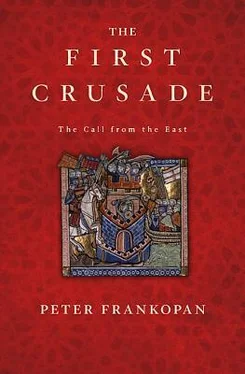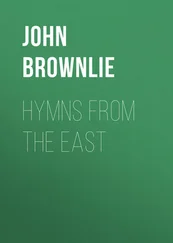Information did not just arrive in the west through official lines of communication. Some of the news from Asia Minor was brought back by travellers and pilgrims who had journeyed to Constantinople or Jerusalem at the end of the eleventh century. Men like Robert of Flanders saw for themselves the position Byzantium was in when he travelled home from the Holy Land in 1089. William of Apulia, writing in southern Italy at the end of the eleventh century, had also heard of the attacks on churches and of the persecution of the Christians but believed that the crisis was the result of the Byzantine emperor having become too close to the Turks, hoping to use them to bolster his own position. 16Given Alexios’ alliances with Sulayman and especially Malik-Shah, there was substance to such views. Yet the assessment that the emperor was to blame for the dire situation shows that the flow of news from the east could not be exclusively controlled by the imperial court.
However, despite visitors to Constantinople and the Holy Land bringing home with them their own stories, the consistency of their reports shows how efficiently, on the whole, information was being managed from the centre. Their content, tone and message were near identical: churches in the east were being destroyed; Christians, especially the clergy, were subject to terrible persecution; Asia Minor had collapsed, with the Turks reaching as far as the Arm of St George; military assistance was urgently required in Byzantium. The narrative was so universal because so much of the information was emanating from the emperor.
One particular element common to many of the reports was the worsening situation in Jerusalem itself. Conditions seem to have become increasingly precarious in Palestine and in the Holy City towards the end of the eleventh century. Although the Turks initially displayed considerable tolerance to non-Muslim communities in this region, the capture of Jerusalem from the Fatimids of Cairo in the 1070s sharpened tensions between the Sunni Turks and Shia Fatimids. A major Fatimid expedition against the coastal region was able to make important gains in 1089, while the death of a leading Turkish commander in battle in 1091 inflamed anxieties futher still. These were taken out on the local population. 17Reports stressed that there were forced conversions of Greek and Armenian Christians in Antioch, and sharp rises in taxes and obligations for Christians living in Jerusalem were accompanied by persecution. 18Jews too were targeted. A major synagogue in Jerusalem was burnt down in 1077, just one example of the harassment recorded in this period. 19
Although recent research has questioned how difficult conditions for non-Muslims became in the 1070s and 1080s, Arabic sources also recorded tensions in Jerusalem, Antioch and the Holy Land immediately before the Crusade. 20One twelfth-century Arabic commentator from Aleppo noted that ‘the people of the Syrian ports prevented Frankish and Byzantine pilgrims from crossing to Jerusalem. Those who survived spread the news about that to their country. So they prepared themselves for military invasion.’ 21Another writer speculated that the conspicuous mistreatment of the Christians in Antioch by the newly appointed governor, Yaghi-Siyan, was bound to provoke a reaction. 22
As a result it had become more difficult for western pilgrims to visit the Holy City. Jerusalem had seen a massive increase in pilgrimage across the tenth and eleventh centuries, spurred on by increasing material wealth, intellectual curiosity and the greater openness to travel that brought about a general contraction of the early medieval world. 23But pilgrim traffic now slowed dramatically as a result of the rise in violence in Asia Minor and the Levant. Shocking stories about the holy places were widely circulated and it was reported that pilgrims were subjected to torture and violence and forced to pay ransoms to the oppressive Turks. 24Peter the Hermit, a charismatic preacher, told an extensive and horrified audience about the ill-treatment he had supposedly experienced on a harrowing journey to Jerusalem. 25Not everybody was put off, however. Roger of Foix persisted in making arrangements to go to the Holy City in the spring of 1095, returning a year later to reclaim his lands in southern France. 26Another knight from Normandy completed the pilgrimage not long after, celebrating his safe return by endowing the abbey of Jumièges. 27But they were the minority; as one chronicler put it, such were the circumstances in the 1090s that few dared even to set off on the journey. 28
This growing concern about Jerusalem in western Europe was exploited by Alexios. With many westerners living in Constantinople at the end of the eleventh century, including several at the very highest ranks of imperial service, the emperor well understood the significance and emotive lure of the Holy City. It was for this reason that in 1083 he called on Euthymios, patriarch of Jerusalem, to witness his peace agreement with Bohemond, ‘that terrible Frank’, after the first Norman attack on Byzantium had finally been curtailed by the emperor. The patriarch’s presence was intended to demonstrate that the invasion of the empire was a matter of concern to one of the most important figures in Christendom. 29
Another example comes from the interpolation to a contemporary Slavonic text. At the beginning of 1091, envoys arrived at the court of King Zvonimir of Croatia, sent by the emperor Alexios and Pope Urban II in the wake of the budding alliance between the Latin and Greek churches that had been forged in Constantinople eighteen months earlier. The envoys described to Zvonimir’s court how Jerusalem and the holy places had fallen to pagans, who were destroying and desecrating these sacred sites. ‘We ask and beseech you, our brother Zvonimir, most pious king of the Christians’, they pleaded, ‘to help us for the love of Christ and of the holy church.’ 30
Alexios’ controversial letter to Robert of Flanders in the early 1090s also seems to have made deliberate use of Jerusalem to elicit a response from the west. If the kingdom of the Christians fell to the Turks, the emperor warned, the Lord’s Sepulchre would be lost forever. 31This twinning of the fate of the Byzantine capital and the Holy City found its way into the chronicles of early-twelfth-century Europe. ‘Disturbing news has emerged from Jerusalem and the city of Constantinople’, wrote Robert the Monk, ‘the race of the Persians, a foreign people and a people rejected by God ... has invaded the lands of the Christians, depopulated them by slaughter and plunder and arson, kidnapped some of the Christians and carried them off to their own lands.’ 32It was a message that could be traced back to the emperor in Constantinople.
Alexios’ championing of Jerusalem was a shrewd move, bound to provoke a reaction among the Christian knighthood of Europe which had become increasingly attuned to the ideals of piety and service. The introduction of sanctions by the church for fighting on Sundays, feast and holy days, helped instil in western knights a Christian ethos that transcended mere fighting and military conquest. 33Although there was a marked difference between rhetoric and practice – demands like those of Ivo of Chartres that anyone who engaged in violence between sundown on Wednesdays and sunrise on Mondays should be excommunicated were undoubtedly ambitious – the attempts of the church to intervene in secular life were striking and clearly made an impact on society. 34
In this context, news of the distress in the east had a particular resonance. With interest in Jerusalem already at almost obsessive levels at the end of the eleventh century, reports about the threat to Christians and to the Holy Land sat neatly alongside the rising fears of an imminent apocalypse. Floods, famine, meteor showers and eclipses all seemed to point to the conclusion that the end of the world was nigh. 35The Pope’s calls to the defence of the church therefore gave the western knighthood a new raison d’être . The promise of spiritual reward for those prepared to go to the aid of the faithful in the east was a seductive rallying call. Alexios’ call for help lit a touchpaper in Europe.
Читать дальше











